One
of the dreams of the early founders of our community was the establishment of a
college in Algona. Rev. Chauncey Taylor
was the first to try when Northwestern College was founded in 1867. One of its instructors, M. Helen Wooster,
left the employ of that college in 1869 and opened Wooster Seminary, which
advertised “Especial attention given to those preparing to teach.” Miss Wooster was later convinced to join a
movement to establish a permanent seminary and used her talents to assist in
the creation of Algona Seminary and College in 1870 which operated until 1880. Harvey Ingham wrote a book
appropriately called “Algona College” which traced the brief history of that
institution of higher learning.
A NORMAL SCHOOL FOR ALGONA
Despite
the failures of the earlier schools, another attempt to establish a college
began in 1886. Professor J. C. Gilchrist
who had formerly served as president of the State Normal School at Cedar Falls,
approached Algona city officials about opening another normal school. A public meeting at the courthouse was
quickly organized for July 14th and was enthusiastically
attended. Professor Gilchrist took the
floor and presented his plan for starting a normal school. His proposition included having the town
provide a suitable building and guarantee $1500 per year for his salary. The presentation was well received and a
committee of well-known leaders and businessmen was formed to study the matter
further. It was soon decided to accept
the Professor’s proposal.
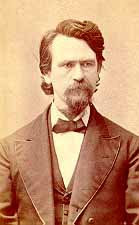 |
| Professor J. C. Gilchrist |
It
seems impossible that a proposal for a college could go from idea to actual
existence in approximately eight weeks even with an experienced college
administrator at its helm. Gilchrist was
determined to make the most of this opportunity, however, and so he wasted no
time in hiring instructors Professor C. F. Reed, a graduate of the state
agricultural school at Ames; Miss Kate Keith of Fort Dodge; Mrs. W. F. Wolf; and
Miss Kate Bernard whose specialty was music.
Opening attendance numbers were estimated at 40 with students from
almost every county in this section of the state.
INTERIM HOUSING
While
plans were being made for the construction of a proper building for the school,
classes opened that fall in the old Algona College building. J.J. Wilson had taken possession of the
structure in lieu of payment and had moved it downtown to the corner of
Nebraska and Dodge streets from its original site in southern Algona. Mr. Wilson totally refitted it for its new
use. A room near the entrance of the
main floor was made into a library where the professor arranged his personal
book collection which was touted as being one of the largest and most valuable
for school purposes in the northwest.
The
private office of Professor Gilchrest was located to the left of the entrance
where the business of the school was conducted and visitors were cordially
received. Beyond the library were recitation rooms. The old hall located on the second floor had
contained a stage and scenery during its Algona College days. They had now been removed so that the room could
be used as both a study hall for students and be available for public use. Fresh wallpaper and new blinds completed the
renovation of that area and brand new Burlington desks were added for student
comfort. In addition, the hall now contained a piano
that had been kindly furnished by J.J. Wilson.
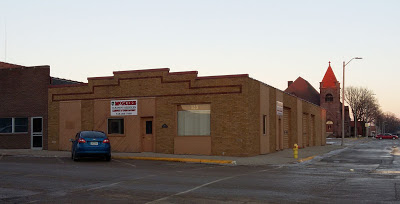 |
Algona College building was located at this site
when used by the Normal School.
The site is pictured as it looks today.
|
An
“Inaugural Day” gathering was held September 14, 1886 to honor the formal
opening of the Northern Iowa Normal School. The evening was filled with many
speeches and musical tributes. Col. J.
M. Comstock delivered the main address which in part stated “I believe that I but voice the sentiment of
the entire community when I say that the establishment of the Northern Iowa
Normal School at Algona is an event which marks a new era in our history, and
one which, as it goes on to its destined success and to state adoption, will
grow into an institution that will not only be the pride of our city, but will
have a reputation extending over the state and out into the national highways.”
Professor
Gilchrist closed his remarks by saying, “Fellow
citizens of Algona, you are laying the foundations of such a school today with
your own hands and from your own purses.
Those who are engaged upon it—trustees and faculty—are keenly sensible
of the responsibilities which they have assumed. I believe that all are deeply anxious and
that only pure motives and unselfish aims control the movement. There lies before us no ordinary task. The liabilities of human error are not
removed from our path. We ask
forbearances of judgment, we ask friendly counsel and cordial support, we ask
that all shall cherish the institution and foster it.”
According
to an article published in the Upper Des Moines newspaper on September 29,
1886, some of the subjects taught at the school included geology, chemistry,
art, penmanship and the classics. The
reporter had the good fortune of listening in on recitations in grammar,
arithmetic and Latin as taught by Professor Gilchrist and one in algebra by
Professor Reed. He also discovered that
one class was reading Cicero’s orations.
The public was encouraged to visit the school at any time to sit in on a
class to see the merit of the institute’s “great
and permanent value to Algona and the northwest.”
PLANS FOR A NEW BUILDING
Plans
to construct a building for a permanent home for the Normal School were soon
underway. A location on a hill in what
was then the eastern part of the city was chosen and a memorandum of agreement
regarding the property was entered into between Asa C. Call and the trustees of
the Northern Iowa Normal school. Judge
Call offered to give to the state of Iowa a fairly large plot of land (almost
ten acres) for its use on which to locate and maintain a normal school. However, the contract was subject to several
conditions. If the state of Iowa should
fail to officially locate a school on that property by the close of the
twenty-second general assembly on or before July 4, 1888, the contract would be
null and void and the property would revert back to his ownership. Further, it was up to the Independent school
district of Algona to move a building to the site and have it repaired and
ready for use no later than June 1, 1887, and the facility was to be furnished
free of rent to the normal school.
The
agreement presented several problems.
Getting the state legislature to officially adopt and provide for a
state-sanctioned normal school in Algona was a major step in and of itself. If legislative approval was obtained, an
appropriation by the legislature for the operations of the school seemed
probable. However, obtaining funding for
buildings and the establishment of a campus was highly unlikely, at least in
the same legislative session.
 |
From 1896 Kossuth County Plat Book
showing location of Normal School near
the corner of Lucas and Wooster Streets
|
Placing
the burden on the Algona school district of furnishing the building rent free
to the college did not seem feasible either.
The district was just completing the construction of Central School and
so they were happy to donate the two wings from the former school to the
construction project. Moving them to the
site and constructing a center section to join them together would cost several
thousand dollars which the district did not have. Then there was the question as to whether or
not the district could legally levy a tax to provide quarters free of rent to any
facility other than a public school.
Many
voices rose in opposition to further school taxes for this endeavor and instead
spoke in favor of raising private contributions to achieve the relocation of
the buildings and the new construction and renovation needed to make them
useful. It was their feeling that the
state legislature would look well upon the private fundraising and therefore
increase the chances of approval of the normal school as a state institution.
CONSTRUCTION BEGINS
Plans
forged ahead and by April of 1887 the two wings of the old public school were
moved to the new site which had now been nicknamed “Normal Hill.” Shortly after their arrival, construction began
on the center section which was 14 feet wide.
A square cupola was placed at the top and heavy cornices gave a
distinctive look to the building. Because of its location on the hill, the view
from the school was one of the most commanding in town, overlooking the
surrounding countryside.
The
division of the rooms were well designed and provided ample room for the needs
of the institution. The entire second
story was left as one large hall which measured 81 feet long by 32 feet
wide. The area would comfortably seat 300
students. The room was used for morning
gatherings, as a study room and also for public meetings and programs.
On
the main floor two recitation rooms occupied the entire north half of the building,
each room measuring 40 by 16 feet. The
south half was divided into a library on the west; a cloak room, vestibule and
stairs in the center; and Professor Gilchrist’s office and a small recitation
room on the east. Coal sheds, outhouses,
and sidewalks were added prior to opening day.
In
early July of 1887, the school board inspected and accepted the condition of
the building. The cost of entire project
came in at $1,686 which was below the $2000 appropriation that had been
approved by the voters.
THE DOORS OPEN
When
the new term convened, everything was ready.
The contents of the library, seats that were used in the College hall
and all supplies had been transported to the new site and arranged. Blackboards had been installed and the
building completely cleaned. Enrollment
was around 80 students with an expectation of more than 100 by mid-term.
In
addition to offering Bachelor of Scientific Didactics or Bachelor of Didatics
degrees, the school also taught a commercial course from three to five in the
evening in the essentials of business including shorthand and typewriting.
Curricula
for the degree programs included mathematics, geometry, spherical trigonometry,
geology, physical geography, English literature, Latin, German, and much
more. Each semester, the school would
present a literary and musical production.
Students would perform orations and recitations such as “Shooting and
Fixed Stars” or “How the Earth was regarded by the Ancients” along with vocal and
instrumental music numbers. The programs
would often include readings from the school’s Literary or Shakespearean Societies.
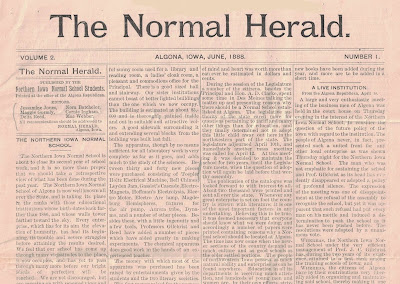 |
The newspaper published by
students of the school.
|
In
March of 1888 thirty-two young ladies who were students at the Normal school
gave a presentation in gymnastics set to music.
Four forms of drill were presented—marches, free hand, Indian club, and
wand exercises—performed in full gymnastics costume to great applause from a
crowded house. The group had been
training for some time and wanted to raise money to purchase more equipment to
expand the program. The community had
never before observed such a program and it was the topic of conversation for
days.
STATE ACCREDITATION DENIED
Great
energy was extended to obtain legislative approval for the school. After efforts failed in 1888, a delegation of
local men again went to the capitol in 1890 to plead with legislators to make
it a State institution, but it was to no avail.
Local representative C.L. Lund missed the vital vote because he had been
told the bill would not be up for vote until the afternoon, so he was not
present at the morning session when it came up on the roster. Would his vote have saved the day? We don’t know but the failure to pass the
important legislation was the last straw for the discouraged Professor
Gilchrest who resigned and took a faculty position with Morningside College.
The
school struggled along for a few more years under the guidance of various
administrators, but then closed in August of 1897. Coincidently, its founder, J. C. Gilchrist,
also passed from this life just a few days after what would be the final
closing exercises were held at the Normal school. He had spent the remainder of his working
life at Morningside College, with the exception of returning to Algona for a
brief time to serve as principal after the sudden death of public school
administrator Professor Dixon. His
obituary in the Upper Des Moines opined, “Prof.
Gilchrist was a strong man. He did not
possess the tact and all-round knowledge of the world to use his strength
advantageously. He had friction where it
was unnecessary. Countless worries
fretted him that he should have known how to throw off. But with all he was a strong man, and one who
has left his mark on the educational work of Iowa. He never lost interest in his Algona project,
and from his bed of sickness anxiously awaiting the end he wrote a letter to
The Upper Des Moines urging Algona to stand by the normal school.”
The
Normal school building would serve the community in one additional capacity
before its demise. By this time Central
School had already been outgrown and a new structure which would be known as
Bryant School was under construction for use as a new high school. For a brief time during construction of the
new facility, high school classes were moved to the Normal school building and
its halls were filled once again with the noise and activity of students.
In
1902 the Algona Independent School district sold the building to A. L. Belton
who sold the center and east wing to John Peterson who tore them down to use
the lumber for building his own residence.
Belton’s intention was to convert the west wing into an egg packing and
poultry house. However by April of 1903
the last remains of the old normal school had been removed and the foundation
stones hauled away, leaving Normal Hill empty and bare—but not for long. Houses filled with families would soon
decorate the hill where a proud educational institution had once stood.
 |
| Normal Hill today |
It
does make one stop and wonder—what would Algona look like today had the Northern
Iowa Normal School been successful?
Until
next time,
Jean
If you enjoyed this
post, please don’t forget to “like” and SHARE to Facebook. Not a Facebook
user? Sign up with your email address in the box on the right to have
each post sent directly to you.
Be sure to visit the
KCHB Facebook page for more interesting info about the history of Kossuth
County, Iowa.
Reminder: The posts on Kossuth County History Buff are ©2015-19 by
Jean Kramer. Please use the FB “share” feature instead of
cutting/pasting.
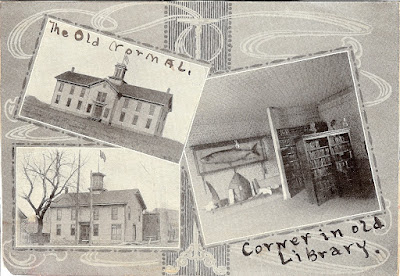
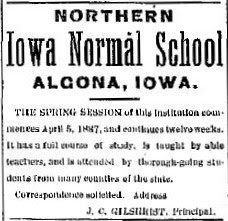

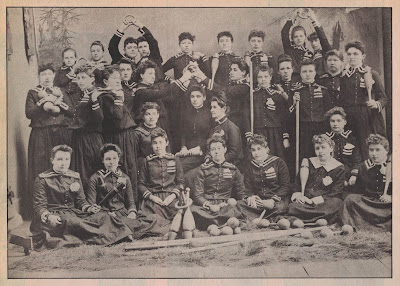
No comments:
Post a Comment